As pool and beach season draw near, you may be thinking about what you need for summer and sunscreen is likely on that list. Us moms tend to worry about this the most as we want to protect our kiddos from any harm. This post will cover share which safe sunscreen brands made the EWG approved sunscreen list.
Just sit back and relax while we dive into some of the least toxic sunscreen options on the market (see what I did there?).
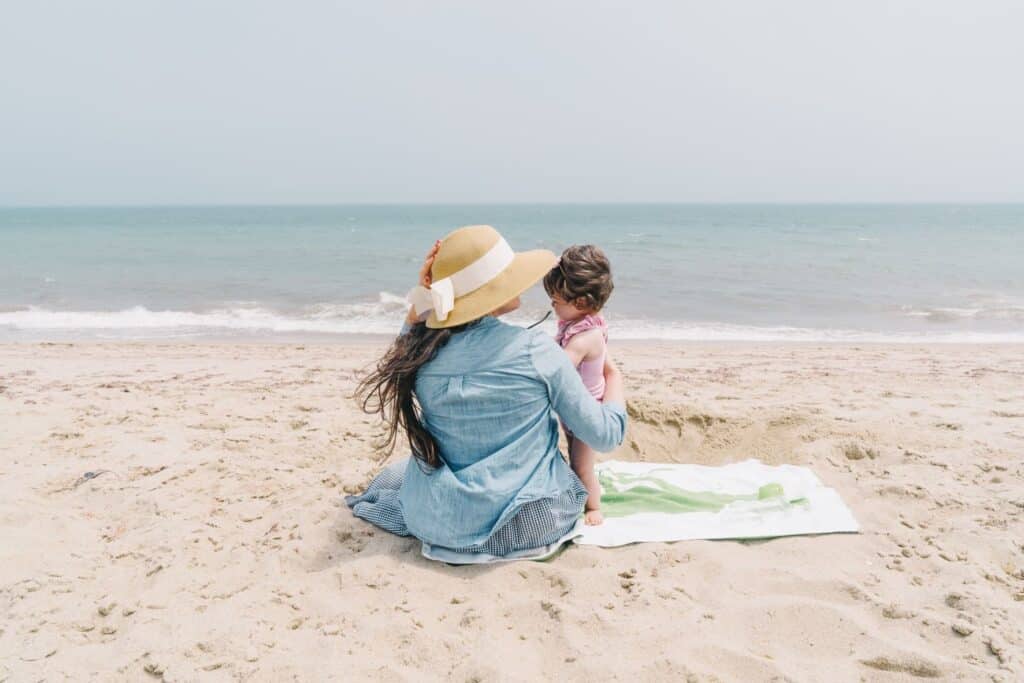
Each year, a few of my mom friends ask me what sunscreen I buy for my kids even some of my friends who aren’t necessarily into the “crunchy” lifestyle. Why is sunscreen such a hot topic? Well, sometimes you need to slather it on infants, which often causes us to pause and think.
Another reason is that many need to use it frequently, sometimes even daily. Depending on your skin type, you may have a hard time being in the sun at all without some type of protection.
Coverage and shade are the safest options, but let’s be honest, no one wants to wear long-sleeves and pants or stay parked under the umbrella all summer long. Plus, you want a little sun, since it’s the best source for vitamin D out there. The darker your skin, the more minutes of direct sun you need.
Watch Out for These Toxic Sunscreen Ingredients
There are concerns about the safety of common sunscreen ingredients: avobenzone, oxybenzone, octocrylene, homosalate, octisalate, octinoxate and ensulisole being some of the most discussed.
In 2019, the U.S. Federal Food and Drug Administration (FDA) classified zinc oxide and titanium dioxide as safe and effective but asked for more research on these commonly used synthetic sunscreen ingredients. Covid has delayed any additional research. Thankfully, the number of mineral sunscreens increases each year.
One often cited study on oxybenzone is: Oxybenzone Alters Mammary Gland Morphology in Mice Exposed During Pregnancy and Lactation. In the spirit of transparency, the mice did eat large amounts of the compound. The American Academy of Pediatrics (AAP) states: “If possible, avoid the sunscreen ingredient oxybenzone because of concerns about mild hormonal properties.”
A few years ago, The European Commission changed their recommendation on the amount of oxybenzone and homosalate they consider safe. The Commission now recommends a concentration limit of 2.2 percent for oxybenzone and 1.4 percent for homosalate. U.S. sunscreen manufacturers, on the other hand, are allowed to use these chemicals at concentrations up to 6 and 15 percent, so they do!
Many U.S. sunscreens far exceed the European Commission’s recommendations. Synthetic sunscreen ingredients are absorbed through the skin and can be detected in blood, urine and breast milk weeks after use.
Sunscreen is absorbed into the skin at a much higher rate than previously believed. Unfortunately, you can’t just rinse it off like you can mineral sunscreens that form a barrier on top of the skin. This is a great case for a natural, mineral-based sunscreen.
What Are the Risks of Synthetic Sunscreens?

Health risks of these ingredients include allergic reactions, skin rashes, hormone disruption and kidney damage. When you use these ingredients in an aerosol spray, you add additional health risks to the lungs, since droplets are often inhaled.
My thought is almost always why risk it if you don’t have to? We have so many affordable, safe and clean sunscreen options right at our fingertips these days.
While the sprays are super convenient, it’s best to avoid them. Your body will thank you and your pool neighbors may thank you too. Surely, I’m not the only one who has gotten a faceful of aerosol sunscreen spray before ;)?
There is substantial risk to our oceans and ocean eco-systems as well. Many mineral sunscreens are also “reef safe.” This simply means the sunscreen will not harm our ocean eco-systems. Some sunscreen ingredients have a negative impact on ocean life.
Hawaii and Key West have gone as far as to ban the sale of sunscreens containing oxybenzone and octinoxate. The EWG has several lists of acceptable sunscreens on their website by category. As I went through the Best Recreational Sunscreen list, I found plenty of sunscreens that scored a 1 or 2.
The EWG uses a 1-10 rating system—1 being the safest and 10 being the least safe. There is also a search bar at the top of the page, where you can look up your sunscreen and get its score.
Not every product is listed in the database, but they do a pretty good job of keeping up products. Some brands have taken the step to become EWG verified. These brands adhere to a list of rules required by the EWG in exchange for a seal of approval.
If you see the EWG seal of approval, you can assume that sunscreen is a fairly non-toxic option.
Do Mineral Sunscreens Work as Well as Synthetic Ones?
Overall, not quite. That was a surprise to me too! I learn something new each time I write a blog post. Because of the way synthetic sunscreen ingredients work, they tend to offer broader protection. Don’t be discouraged though—most mineral sunscreens work very well.
You want to be diligent when applying and reapply slightly more often. Mineral sunscreens tend to be harder to spread, so be sure to get an even layer on all exposed skin.
What’s up with the Chalky Residue?
One downside to mineral sunscreens is that they tend to leave behind a white, chalky residue or “white cast” as some call it. This is actually a good sign though. Mineral sunscreens sit on top of the skin and creates a barrier to block the sun. It isn’t absorbed by the skin, which is part of the problem with synthetic sunscreens.
My kids don’t mind the mummy look (they may one day!), and the residue can help you see spots you may have missed. For myself, I could do without the chalky residue, so I have switched to Babo Botanicals Clear Zinc Sunscreen, which has been around a couple of years now.
Having a safe and non-toxic sunscreen that doesn’t leave a white cast behind is a breath of fresh air. Think also offers a clear zinc sunscreen, and I like it almost as much as Babo.
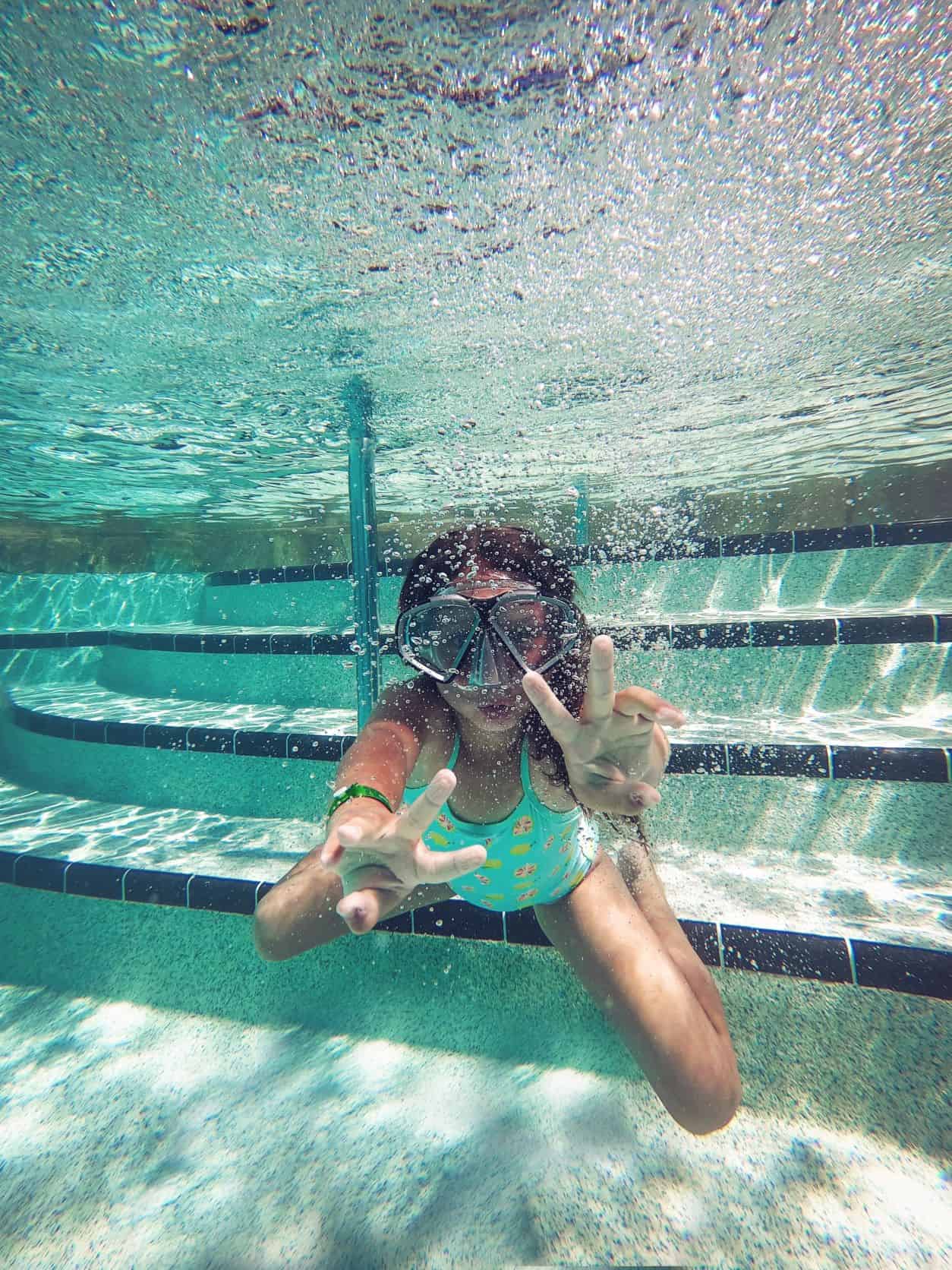
This post may contain affiliate links. I may earn a small commission on qualifying purchases.
EWG Approved Sunscreen List
It is VERY important to remember that just because one product rates well, does not necessarily mean that a similar product of the same brand will. One brand in particular I looked at had a sunscreen with a rating of 2 and one with a 10. Be sure to type the full and exact product name into the database.
Badger
Badger is a family-owned business, and they manufacture in their very own post-and-beam facility in rural New Hampshire. They keep it super simple with their ingredients, which I appreciate.
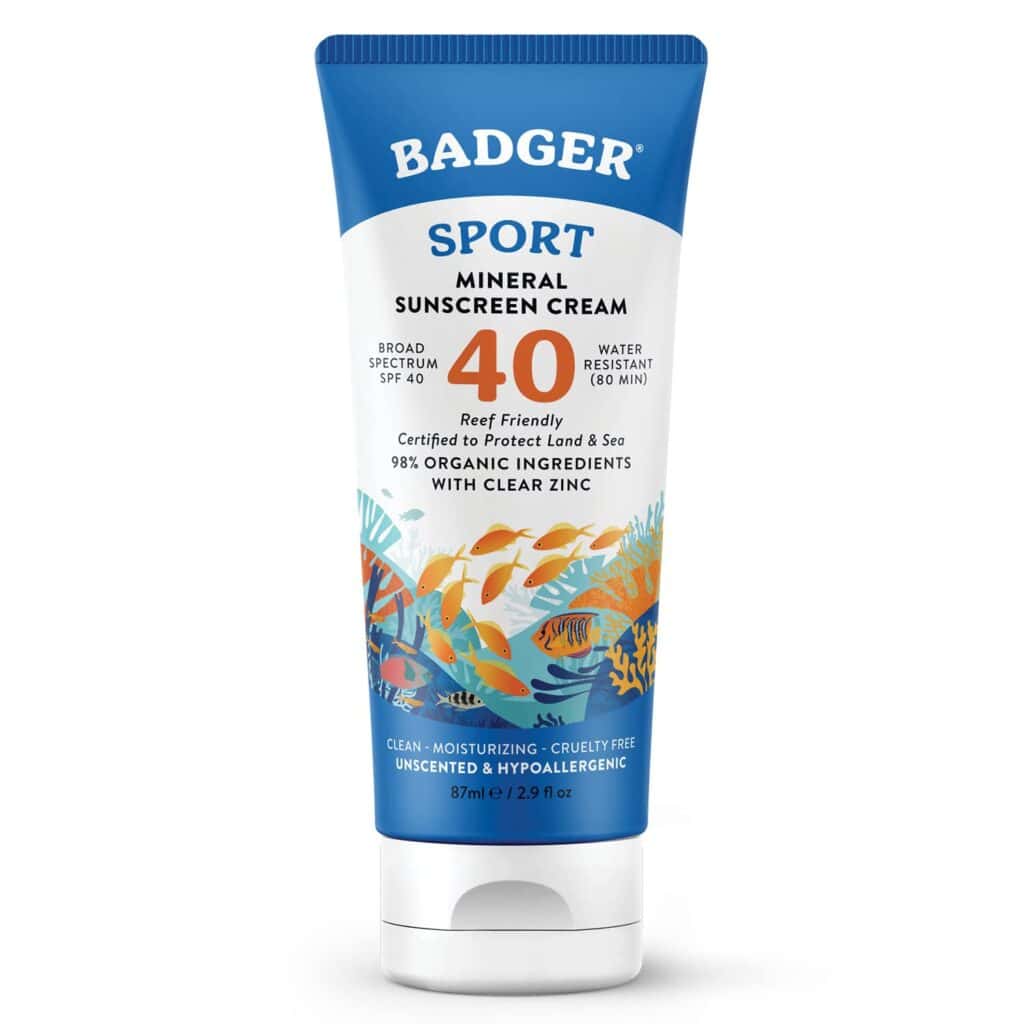
Their products routinely score a 1. They have a whopping 7 sunscreens on the EWG Approved Sunscreen List (Best Recreational Sunscreens).
Think, Think Sport and Think Baby
Think, Think Sport and Think Baby are all under one brand. Most of their products score a 1 with a couple scoring a 2. They have an adult sunscreen, kids sunscreen, active/sport option and a sunscreen stick. Think now offers a clear zinc sunscreen option. Some customers complain about separation of ingredients.
You can snag Think at Amazon (linked above), Target or off their website.
All Good
All Good is new to me, but they have 9 sunscreens on the EWG Approved Sunscreen List (Best Recreational Sunscreens)—wow!
There were a few reviews on Amazon that mention inconsistent coverage, so be aware of that if you give it a try. You can purchase it on Amazon, Wal-Mart, Target or from their own website. It’s pretty affordable too.
EWG Approved Sunscreen—Honorable Mentions
These sunscreens have an EWG rating of 2, which is still impressive in the sunscreen world.
Babo Clear Zinc Sunscreen
Babo Botanicals has a score of 2 by the EWG and provides UVA/UVB protection and is water/sweat resistant for up to 80 minutes. It is non-nano meaning the particles are too large to penetrate the skin. Mineral sunscreens work by offering a physical barrier between the sun and our skin.

Babo is also reef safe. And, yes, it really goes on clear! This is what I am currently using, because I am sold on the clear zinc technology. For more insight, see my full review of Babo Sunscreen.
Ethical Zinc uses zinc oxide certified by ECOCert. The brand is cruelty free, reef safe, hypoallergenic and, to top it off, they use solar energy to run their facility.
Jason
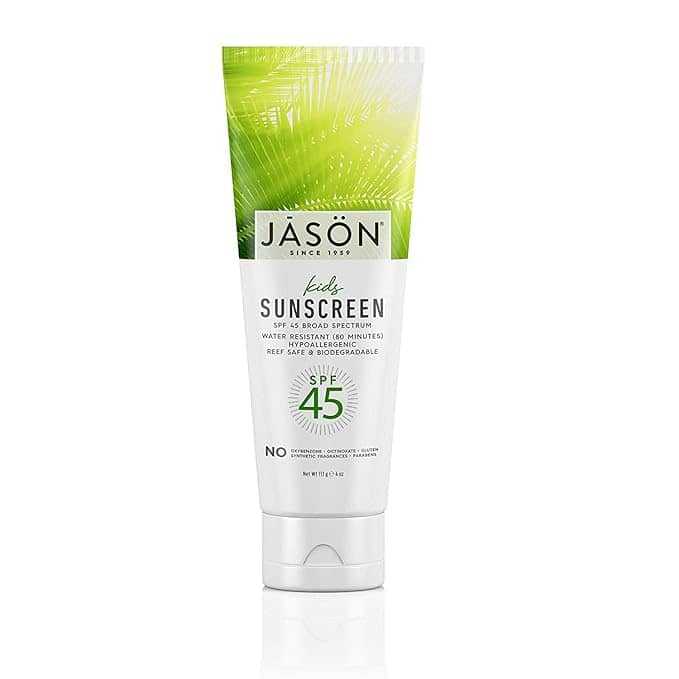
I’m a big fan of Jason products. You won’t find them sneaking questionable ingredients into their products, and all of their products routinely rank at about a 2 via the EWG rating system. It’s easy to find and pretty affordable. Their sunscreen is available at Amazon and Target.
California Baby
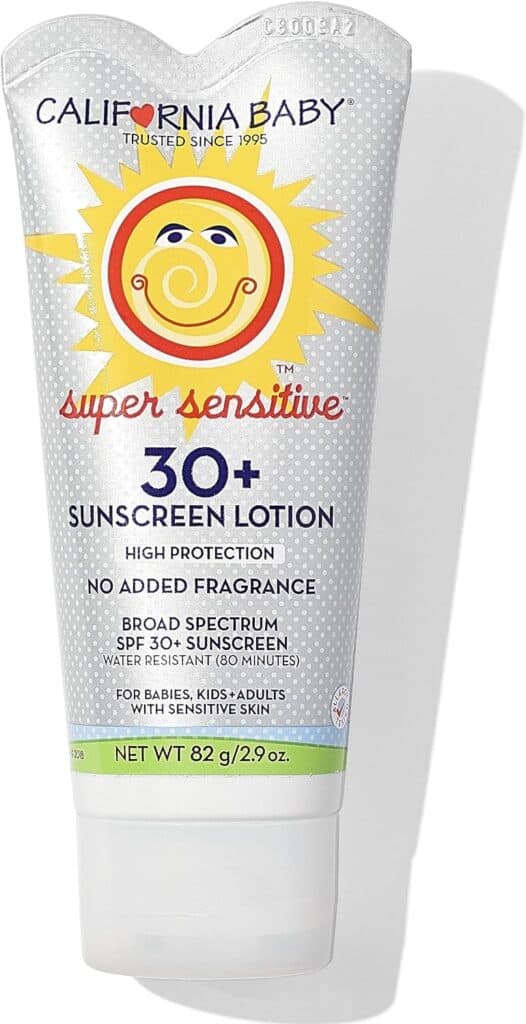
California Baby is not just for babies, but it’s safe enough for babies! This brand has a good reputation for safety, but the price is a little higher than some of its competitors. They offer a lotion and a stick. You can buy California Baby at Amazon (linked above) or from the California Baby website.
Ethical Zinc
The EWG usually runs behind on product recommendations, because their evaluation process takes time, so I suspect more clear zinc sunscreens will earn their recommendation before summer is over. Ethical Zinc Mineral Sunscreen, an Australian brand, looks like a promising option.
On a Budget?
I like to always provide a budget-savvy option, because I want everyone to have access to safe and clean personal care products. The cheapest clean sunscreen I can find online right now is Alba Botanica Hawaiian Sunscreen Lotion, Aloe Vera, SPF 30.
Not many Alba sunscreens are currently on the EWG recommended lists, but this particular one has a rating of 2 and is currently under $9 on Amazon. I have also had luck finding some of these clean brands at TJ Maxx and Marshalls at a discounted price, so you can always check there if you have one near you.
Sunscreens to Avoid
This post wouldn’t be complete if it didn’t include a few popular brands that you may want to avoid, especially for little ones. These sunscreens range in score from 7-10, use synthetic ingredients that we need more safety information on and may be aerosol sprays that can be harmful to little lungs.
Banana Boat
Banana Boat Kids Clear Sunscreen Spray and The Banana Boat Kids Sport Spray earn an F. These sunscreens use avobenzone, homosalate, octisalate, octocrylene and oxybenzone in an aerosol spray form. Note:
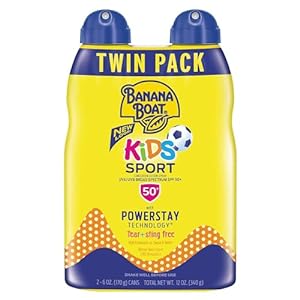
The exact name has changed slightly this season, but the formula is the same as the older version listed in the EWG database.
It’s also worth noting that experts warn anything listed over 50 SPF is likely inaccurate. A SPF 100 sunscreen does not offer double the protection of a SPF 50.
Neutrogena
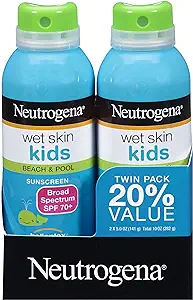
I specifically wanted to mention Neutrogena, because many people think of it as a health conscience brand, Its sunscreens often landed at 7 and there were several that scored 10 as well. Here are just a few to beware of:
Neutrogena Wet Skin Kids Sunscreen Stick, SPF 70+
Neutrogena Ultra Sheer Dry-Touch Sunscreen Lotion, Broad Spectrum SPF 70 both earn a 7.
Neutrogena Beach Defense Water + Sun Protection Sunscreen Lotion, SPF 70 scores a 10.
Coppertone
This is another household name that I feel like people often grab when they are in a hurry, Coppertone Kids Sunscreen Lotion, SPF 70 and Coppertone Sport Sunscreen Continuous Spray, SPF 30 were given a 7.
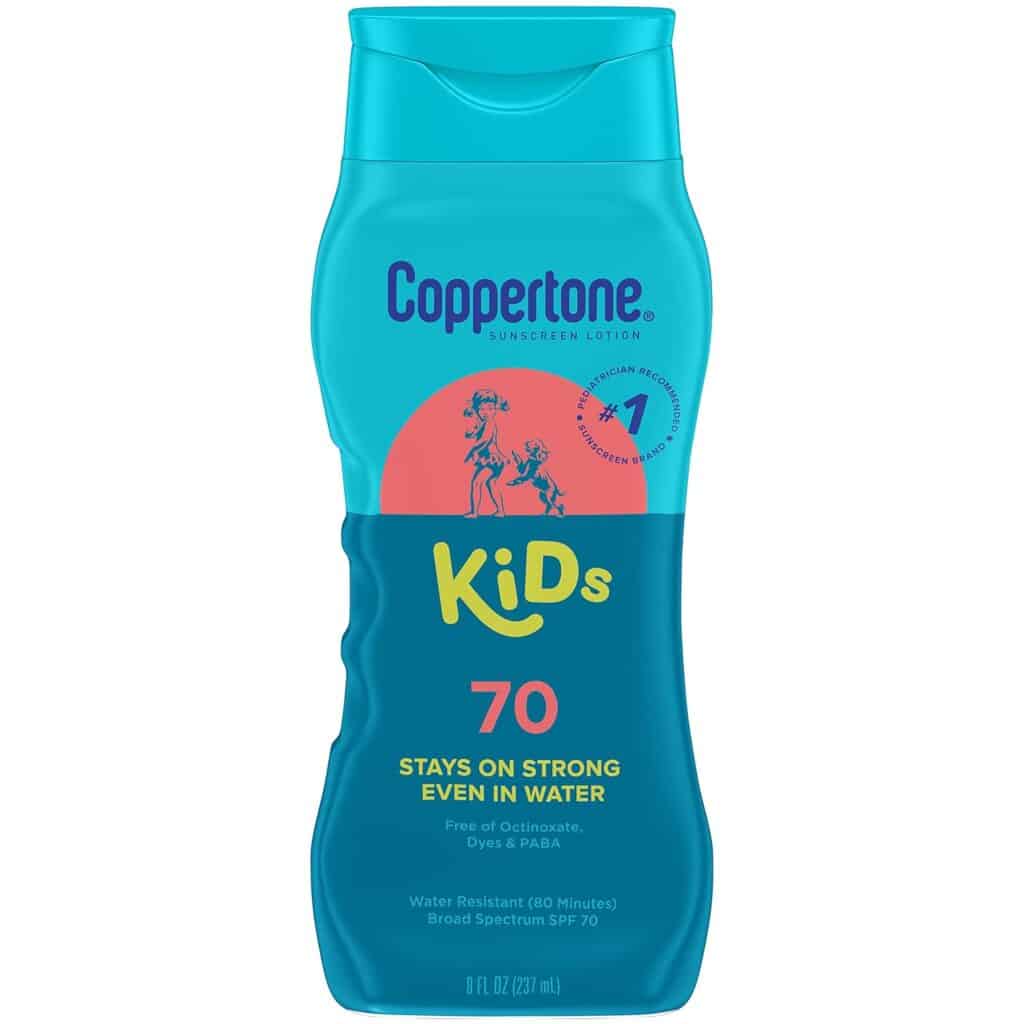
The kids lotion states that it is pediatrician recommended and free of octinoxate. Keep in mind that recommendation is based on sunburn prevention and not necessarily the safety of ingredients.
I found it a little ironic that the brand chose to remove octinoxate (banned in Hawaii and Key West) and use it as an advertising point but left in other equally controversial ingredients like oxybenzone (also banned in Hawaii and Key West) as well as avobenzone, homosalate, octisalate and octocrylene. Things that make you go hmmm…
Takeaways
To recap, look for an active ingredient of zinc oxide or titanium dioxide. These are usually branded as natural or mineral sunscreens. Go for a lotion over a spray, especially over an aerosol spray.
Check the EWG database for your exact sunscreen (including the SPF) and preferably choose a sunscreen on the EWG Approved Sunscreen List. Cleaning up your summer routine? Check out my post on safe and natural pest management.

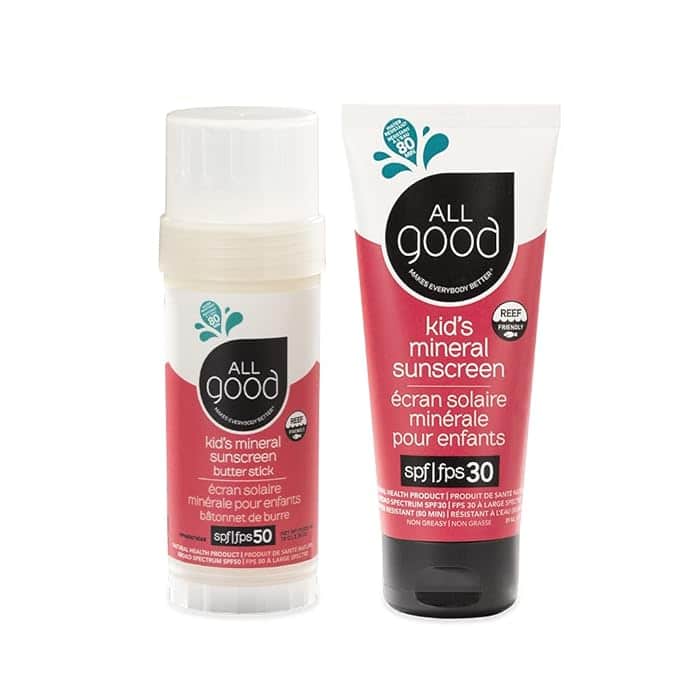

Such great information… I feel comfortable choosing a good sunscreen now!
Good to know these details, thank you!!